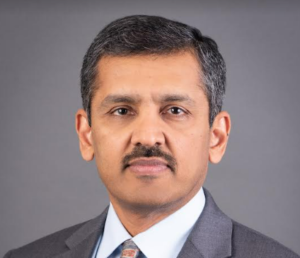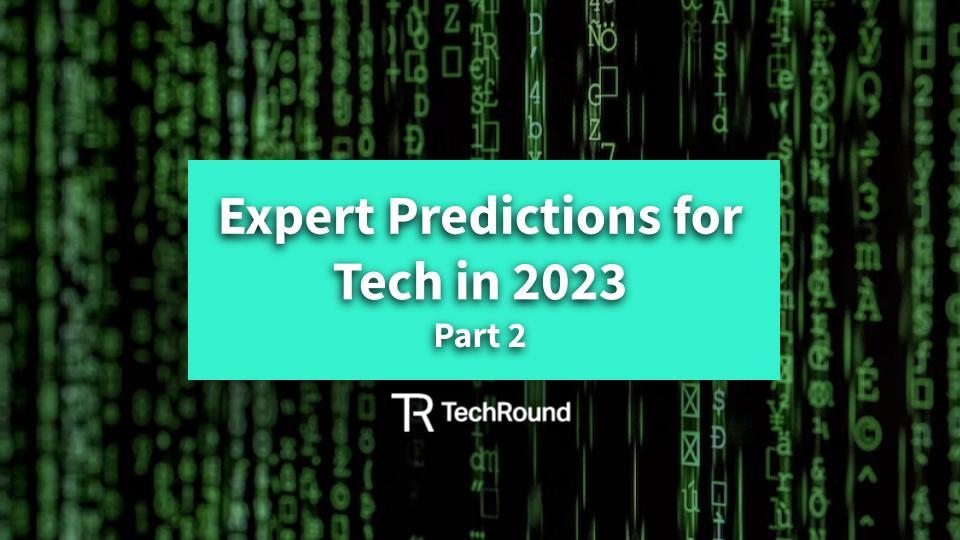We’ve collected industry expert predictions on tech trends that will shape 2023.
As we enter 2023, it’s hard not to reflect on the evolution of technology over the past year. From crypto to AI, through to emerging sectors in the startup space and the expansion of blockchain, it has certainly been an eventful year.
We asked a panel of industry experts to give their predictions on what trends they think will shape this year…
For more predictions, see part 1 here.
Our Panel of Experts
- Tim Harrison, CEO and Founder at Arkus
- Jason Stirland, CTO at DeltaNet International
- Emma-Louise Fusari, Founder at In-House Health
- Allan Aikman, Product Design Manager at Pinpoint ltd
- Gabriel Aguiar Noury, Robotics Product Manager at Canonical
- Steve Sell, Director of Public Cloud Services at Nasstar
- Charlie Casey, CEO at LoyaltyLion
- Harry Hanson-Smith, Regional Vice President at Dynamic Yield, A Mastercard Company
- Ian Moore, Founder and Head of Services at Excellent Zephyr
- Pascal Bensoussan, Chief Product Officer at Ivalua
- Victor Fredung, CEO at Shufti Pro
- Ashok Reddy, CEO at KX
- Michele Szabocsik, VP of Product Marketing, BlueConic
- Kevin Thompson, CEO of Tricentis
- Krijn De Nood, Co-Founder and CEO at Meatable
- Werner Knoblich, Chief Revenue Officer at Mambu
- Iain Rolfe, APAC director at Newfound Global
- Chris Halbard, EMEA President at DXC Technology
- Pankaj Sharma, Executive Vice President at Remitly
- Halit Develioğlu, Founder and CEO at OPLOG
- Luke Beavon, CFO at SumUp Payments UK
- Stefan Hauswiesner, CEO and Co-Founder at Reactive Reality
- Andrew Whaley, Senior Technical Director at Promon
- Naveen Zutshi, CIO at Databricks
- Daniel Bailey, VP EMEA at Amplitude
- Brad Hyett, CEO at phos
- Rodolphe Ardant, CEO and Founder at Spendesk
- Ben Putley, CEO and Co-Founder at Alkimi
- Harriet Durnford-Smith, CMO at Adverity
- Rob Sewell, CEO at SmartFrame
- Marc Ramos, Chief Learning Officer, Cornerstone
- Tom Cuthell, VP at London Tech Week
- Sascha Giese, Head Geek™ at SolarWinds
- Angel Maldonado, CEO at Empathy
- Louise Hill, Co-Founder & COO at GoHenry
- Jim Herbert, CEO at Patchworks
- Carl Walker, Ecommerce Director at Fluid Commerce
- Taavi Kotka, CEO at Koos.io
For any questions, comments or features, please contact us directly.

Tim Harrison, CEO and Founder at Arkus

“We are all aware of data and we are all creators of data. Long gone are the days of piles of paperwork – they have become mountains of digital data. The Global DataSphere is expected to reach 101 ZB in 2022 and more than double in size from 2022 to 2026. One zettabyte is equal to a trillion gigabytes. With the enormity of data now being generated, the process of identifying relevant electronic documents within litigation matters is vital and more complex than ever.
“In 2023, legal teams will need experts, specialists, and the best technology to support eDiscovery. As well as the best global tech available, a people-oriented, consultative approach will be needed to find the finer details within large data sets.
“From simple emails through to more complex communication pathways, each element that could be relevant or not relevant can be identified earlier in the process safely and securely, so that relevant information is not missed, and the right outcome is reached.
“The time is here for the legal world to embrace data and tech megatrends. Well known cases like Wagatha Christie are simply the beginning.”
Jason Stirland, CTO at DeltaNet International

“As seen by some major tech players, the tech industry will continue to embrace remote working as a standard routine, with many offices becoming considerably redundant. Many employers will adopt a more flexible arrangement, e.g. using flexible structures such as WeWork to reduce office space but still have a base.
“Unfortunately, from a cybersecurity perspective, this will make phishing attacks a lot easier – particularly around impersonation, as it won’t be as easy to pop into the office to speak to the manager quickly. This is where businesses will need to invest in educating the workforce, especially with many being remote, understanding how to spot phishing attacks to reduce the risk of these taking place. This will force businesses to prioritise end-user security in 2023.
“With businesses relying on employees working in remote locations, I’d expect to see an increase in eLearning, particularly around cybersecurity awareness, as companies look to counter the risk and educate their workforce.”
Emma-Louise Fusari, Founder at In-House Health

“2023 will continue to see a rise in community focussed technology and in two main areas: brand authenticity and connection.
“As we start a new year, it feels as if the world is spinning out of control. So is consumer trust. Meaning customers are turning to brands that have purpose and offer them a great experience.
“Brands that use technology and digital tools to deepen connection, have honest conversations with their community about global issues and create long-term relationships will thrive. If the past few years have taught us anything, people are hardwired for connection. As we jump out of the pandemic frying pan into a cost-of-living crisis fire, the current pressure on people financially is resulting in people cancelling gym memberships, cutting streaming subscriptions and cancelling nights out with friends.
“These cuts may exacerbate loneliness as people drop social activities, resulting in them seeking connection from online communities to stay mentally well. To meet people’s wellbeing needs, I can see the demand for ‘pop-up communities’ growing in 2023. Pop-up communities offer valuable experiences that are delivered against specific objectives and are then wrapped-up once those objectives are met.”
For any questions, comments or features, please contact us directly.

Allan Aikman, Product Design Manager at Pinpoint ltd

“A few trends shaped by the pandemic will continue. First and foremost, the supply chain is still catching up with demand – so the “fast fashion of tech” that we’ve grown accustomed to will continue to suffer. I personally think that this is a good thing with a view to reducing E-waste and the human rights issues associated with cobalt mining.
“More products and services that focus around a hands off/no contact method – a habit again borne from the scars of the pandemic. This means more digital services – remote appointments etc – all the way down to the continuing rise of the self-scan checkout and “touch to pay” methods. This of course will necessitate more tech to facilitate all of these hands-off approaches.
“Finally, the humble QR code – despite being invented in 1994 and having a slight revival with the integration of web 2.0 in the early 000’s has enjoyed a large resurgence thanks largely to the pandemic. I think we’ll continue to see QR codes used in a variety of situations from checking a restaurant’s menu all the way up to being able to find a datasheet or manual for a piece of industrial equipment – or order spares for it.”
Gabriel Aguiar Noury, Robotics Product Manager at Canonical

“The evolution of social robots: In 2023, social robots will be back. Late in 2022, we saw companies like Sony unveiling robots like Poiq. This set the stage for a new wave of social robots. Powered by natural language generation models like GPT-3, robots can create new dialogue systems. This will improve the robot’s interactivity with humans, allowing robots to answer any question. Social robots will also build narratives and rich personalities, making interaction with users more meaningful. GPT-3 also powers Dall-E, an image generator. Combined, these types of technologies will enable robots not only to tell but show dynamic stories.
“But, this is not only about the novelty effect. Dall-E will keep pushing research to help robots define their behaviour based on their surroundings. As image detection and context generation merge, robotics scene awareness and social intelligence will take a new leap. By generating a detailed textual description of an image, robots will soon be able to understand the room they are in or what people are doing. This is another step towards real autonomy.
“However, we cannot be blind to the misuse of technology. The war in Ukraine has made it clear that robots have a market. The Institute for the Study of War has signalled drones as essential as shells. Their large-scale deployment makes this the biggest “drone war” we have seen. Autonomous vehicles have also found a niche in the conflict, allowing armies to transport equipment. Underwater drones as well. Outside this war, China’s Kestrel Defense has also posted videos of a quadruple robot launching munitions or carrying a machine gun.
“Unfortunately, in 2023 we may confirm that the world has started a new arms race. Far are the days of the EU’s ban on killer robots. This war has likely set the stage for what is to come.”
Steve Sell, Director of Public Cloud Services at Nasstar

“Continuous Optimisation: 2023 will see a major focus on the theme of continuous optimisation to ensure that a business can maximise ROI and explore all options available within public cloud services. Having a consistent approach to optimisation and scaling networks and solutions in unison with demand and event drive architectures will play a key role in this story in 2023.
“Cloud Data Security: Data security is extremely relevant in the realms of the cloud environment for customers who have cross-platform solutions and a mobile workforce where data needs to be transmitted and accessed outside of the cloud for users and employees. Joining up connectivity and cloud application solutions is a key factor that will play an important role in 2023 onwards to fight this battle.
“Next Gen Managed Services: Over recent years the AWS Well architected framework has become the best practice approach to designing and evolving solutions within public cloud.
“This framework drives excellence within the pillars of Operations, Security, Reliability, Cost, Performance and Sustainability. In 2023 and beyond we will see an increasing need for these best practices to be embedded into MSP frameworks.”
For any questions, comments or features, please contact us directly.

Charlie Casey, CEO at LoyaltyLion

“Integrations will be the key to success in 2023: The most impactful trend this year is making sure that each part of the tech stack talks, integrates and automates effectively. Companies can have the best tools in the world, but if they’re working independently and not driving the same KPIs then businesses won’t see the best ROI from their tech spend. Tech should be aligned with overall business goals and KPIs – if the focus is retention, then companies must make sure they all tools are working hard together to deliver on that goal.
“Automate to innovate: With tech now readily available to streamline processes, businesses should leverage this to make time for creativity, strategising and most importantly, growth! The more tech can be used to build flows and automations the more time can be freed up to do the more impactful and fun parts of the job.
“Use technology as the vehicle for marketing success: Build marketing activity and segments into your marketing tech. Companies should identify their ICP, key personas or most valuable customers, and ensure those segments are available and identifiable across every piece of technology. There is fierce competition this year and retaining customers through targeted, tech-driven marketing communications is vital.”
Harry Hanson-Smith, Regional Vice President at Dynamic Yield, A Mastercard Company

“Brands are switching to a headless setup to power a more nimble and responsive front end with a more cost/energy efficient back end. Headless is no longer a buzzword – it’s the secret ingredient to success.
“The benefits are clear. One backend can power several frontends – think a website, a mobile app, a digital kiosk, a POS system, and more – which makes integrations with other systems easier and more flexible. And with personalisation layered in, you can improve engagement and optimise conversion and acquisition to build long-term loyalty.
“While implementing a headless infrastructure requires a special set of skills and technical knowledge, this architecture is widely endorsed by industry experts. In fact, an independent not-for-profit group of tech companies dedicated to advocating for open, best-of-breed ecosystems forged the MACH Alliance so brands could find solutions to meet the group’s high infrastructure standards (Microservices based, API-first, Cloud-native SaaS, Headless).
“So although companies will need to invest in talent development to get their setup to standards, that investment will pay off as more innovators join the fold in 2023.”
Ian Moore, Founder and Head of Services at Excellent Zephyr

“Reliable real-time data integration: At times of uncertainty being able to rely on data is pivotal in scaling commerce operations. This year we will see more companies understanding the need to integrate their commerce, ERP, and logistics platform, to allow order, product, financial, and customer data to be seamlessly passed into the correct systems. Being able to see what’s happening on the production floor in real time, the ability to pinpoint the origin of an issue with the supply chain or the amount of stock remaining on shelves will be essential in 2023. Tech to enable data integration will let companies make smarter and better informed business decisions.
“Intelligently automating data: Work smarter, not harder is the phrase that comes to mind. Using “flows” to automate specific business operations will reduce manual labour costs and save businesses valuable time, resources and money.
“End-to-end solutions: With the growing volatility in the UK, integrating an end-to-end solution is essential to allow businesses to scale up operations without risk and provide a single view of the business across all channels. This will ensure customer, order, inventory and financial information is always up to date and that companies can deliver the experience customers expect across every touchpoint.”
For any questions, comments or features, please contact us directly.

Pascal Bensoussan, Chief Product Officer at Ivalua

“Invest in AI and automation to do more with less: In 2023, procurement teams will be facing pressure from inflation, a likely global recession and continued disruptions. With 81% of procurement teams feeling pressured by executive teams to respond more quickly to these challenges, it’s clear that firms will have to do more to keep up, but often without the budget to support this. This is a golden opportunity for procurement leaders. If ever there was a time to invest in AI and automation, it’s now.
“Doing so will help automate time-consuming manual tasks such as invoice approvals and processing POs, streamline processes such as supplier onboarding, and eliminate manual data entry errors. This will reduce the burden on teams and allow them to spend more time on high-value tasks and decision making. As organisations look to navigate future challenges, maximising efficiency and reducing the time spent on repetitive administrative tasks is essential to keep their heads above water.”
Victor Fredung, CEO at Shufti Pro

“It’s clear that fintech is booming with the multitude of repayment plans and online finance options available today, and all of these various platforms require user verification. With options including biometrics and blockchain, all whilst maintaining a seamless user experience, what does the future of fintech look like in 2023?
“Many users have adopted fintech technologies for its renowned inclusive, and secure approach. But with time consuming onboarding processes, consumers are often swayed towards competitors. As the fight for user attention continues, we’ll begin to see a greater development and adoption of quick, efficient verification processes on fintech platforms. Since many of these platforms offer similar capabilities, there will be a huge shift towards the customer experience and benefits, instead of optimising the IDV offering alone.”
Ashok Reddy, CEO at KX

“Industries in 2022 are generating something along the lines of 2,000 TB of data each day, and this seemingly unlimited flow of information is only expected to increase over the next few years. It is believed that by 2025, smart workflows and seamless interactions among humans and machines will become standard, and data will infiltrate — and optimize — nearly every aspect of work.
“As the data-driven enterprise becomes the new standard, so too will real-time data, which enables and accelerates better insights, business innovation and value. In fact, 90% of firms believe that to remain competitive over the next 3 years, they need to increase investment in real-time data analytics; in a separate survey, another 80% of companies saw their revenues increase after implementing real-time analytics.”
For any questions, comments or features, please contact us directly.

Michele Szabocsik, VP of Product Marketing, BlueConic

“A complex patchwork of new data privacy-related laws is set to go into effect in 2023. Combined with the sustained march towards third-party cookie deprecation, ending with Google’s death of the cookie in 2024, these factors are accelerating the need for companies to not only maximize the use of consented first-party data, but also extend its value through second-party data sharing.
“In 2023, we’ll see more companies turning to data clean rooms as a solution for conducting privacy-compliant, second-party data sharing with trusted partners in a secure environment. There will be a strong desire to cut out intermediaries in this process, such as walled gardens and identity graphs. Instead, companies will start using their own data clean rooms so they can maintain full control over who can access the data and how it can be analysed and activated. It will also provide an opportunity for companies to strengthen commercial relationships with their direct partners in a way that delivers mutual value.
“Data clean rooms enable marketers and advertisers to collaborate with strategic business partners to uncover actionable new insights about their shared audiences, measure the impact of marketing and advertising campaigns on a shared audience, and activate valuable new audiences that would have otherwise been undiscoverable.”
Kevin Thompson, CEO of Tricentis

“As the amount of data grows with the rise of 5G and IoT connections in 2023, so does the need for investment in secure solutions. The general public has become more aware of the access companies have to their personal data, leading to the impending end of third-party cookies, and other similar restrictions on data sharing.
“However, security issues still persist. The persisting influx of new data across channels and servers introduces greater risk of infiltration by bad actors, especially for enterprise software organizations that have applications in need of consistent testing and updates. The potential for damage increases as iterations are being made with the expanding attack surface.
“Now, the reality is a matter of when, not if, your organization will be the target of an attack. To combat this rising security concern, organizations will need to integrate security within the development process from the very beginning. Integrating security and compliance testing at the upfront will greatly reduce risk and prevent disruptions.”
Krijn De Nood, Co-Founder and CEO at Meatable

“The demand for meat will continue to increase. We will see the cultivated meat industry really ramp up, with more companies entering and more collaboration. Why? Because we’re headed towards a $25 billion cultivated meat market by 2030, and this is going to require cultivated meat producers to evolve as well, along with the evolution of media components, bioreactors, and other equipment.
“The future of food is here – what you can expect to see in your grocery aisles and on your plates. We’re set to see more cultivated meat products offered as alternatives to traditional meats. If the cultivated meat industry wants to be taken seriously, it’s got to focus on making the foods people already eat more sustainable and responsible. We want to provide products that will have a global impact, as that’s where we’ll see the biggest reduction in demand for traditional agriculture and the biggest reduction in the carbon emissions that come with that.
“If there is one thing that is certain, it’s that 2023 will be another year of exciting change. For the cultivated meat industry, that means continuing to find innovative ways to combine technology and human ingenuity to make cultivated meat an everyday reality for people and the planet. Now more than ever, the world may be a volatile and confusing place, but this industry is dedicated to navigating its complexities and building a sustainable, healthier planet for 2023 and beyond.”
For any questions, comments or features, please contact us directly.

Werner Knoblich, Chief Revenue Officer at Mambu

“In 2022, the financial sector experienced rising interest from big tech. By and large, big tech has the resources, reputation, and technology to give them a competitive position in the market. We saw this in action when Apple introduced Tap to Pay early last year, then later went on to partner with PayPal. With early successes, it won’t be long before other large players follow suit.
“This isn’t necessarily bad. The fintech space is crowded. Overstretched valuations of high-growth companies are coming down to earth. As we’ve seen many times before, crisis breeds opportunity. In 2023, I believe we’ll continue to see opportunities arise where fintechs are seen as more of a friend than a foe. The moment is ripe for fintechs and banks to partner more closely to adapt to the changes 2022 presented. After all, agility in uncertain times is in a fintech’s nature and by design what they’re built to do.
Iain Rolfe, APAC director at Newfound Global

“2023 will be a year of technology reinvention powered by AI, relationship reinvention powered by new ways of interacting, media reinvention powered by hybrid media, and business reinvention powered by predictive analytics.
“We will reinvent existing technological solutions by adopting and embedding AI into their design fabric. AI will enable the industry to be more personalised, faster, and self-improving. It will also power the invention of new solutions that simply can’t exist today.
“We will reinvent our relationships by enabling technology to transmit nonverbal cues and even support a level of emotional communication. This may look like infusing biometric data into messaging pathways or using facial recognition to assess participant engagement (privacy issues aside).
“We will continue reinventing media by moving to a full hybrid media model. If you’re reading an online newspaper, you will also be reading embedded tweets, toots, pictures, and blogs. Consequently, major social networks will reluctantly enable fuller content cross-sharing, and we will continue to self-document the news itself, as seen in the Russian-Ukrainian conflict.
“Finally, new ways of predicting future customer demands, assessing operating processes, and analysing finances will be normalised. Simulation, xP&A, and dynamic process optimisation will lead the way, but many more business-level solutions will follow, revolutionising the way we manage our businesses and organisations.”
Chris Halbard, EMEA President at DXC Technology

“Cybersecurity attacks will target critical national infrastructure: Operational technology (OT) cyber security will become an emerging battleground, with cyberattacks on systems controlling critical civilian infrastructure, such as power stations and dams. With many of these systems now connected to the internet, they will become increasingly prone to external malicious attacks at a time of growing geopolitical tensions.
“The metaverse will transform workplace collaboration: Much like the trajectory of the internet, the metaverse will become part of daily work routines for a growing number of employees. Instead of staring at a grid of 2-dimensional faces, colleagues will be able to choose their seats at a virtual table, pop out of the room for a break and even go on virtual walks with their boss. This new virtual age will see increases in diversity and inclusion, helping to empower employees to find their voice and creativity.
“The metaverse will revolutionise brand expression: Business-to-business brands will increasingly open customer experience centres in the metaverse to demonstrate solutions and services beyond the conventional four walls. At DXC, we have already created a metaverse experience centre where customers can meet with our experts and experience ‘virtual-hand’ the services we have to offer.”
For any questions, comments or features, please contact us directly.

Pankaj Sharma, Executive Vice President at Remitly

“Remittances is a huge industry – there are over 280 million immigrants around the world and many send money abroad to support family and friends. In 2022, the amount sent to low- and middle-income countries was estimated to be $626 billion.
“In 2023, fintech companies providing a superior customer experience will be strongly positioned to capture an outsized share of this market. Like all customers, immigrants sending money abroad want to use technology designed for them. This means a convenient app experience, with fast, reliable money transfers at a fair price that is easy for their recipients to receive. With the rising cost of living and increased inflation around the world, the money that immigrants send back home is critical to improving and supporting the lives of their loved ones.
“The fintech industry is well-positioned to create and drive innovative and inclusive customer experiences, specifically designed for immigrants, in a way that traditional financial services cannot. In 2023, fintech players will continue to better understand the barriers facing immigrants in the financial sector and how to leverage technology to overcome them.”
Halit Develioğlu, Founder and CEO at OPLOG

“In 2023, consumers will become increasingly conscious of the environmental impacts of shopping. If retailers are to address this, they must look to adopt green initiatives through which products can be sourced locally, manufactured sustainably, shipped efficiently, and recycled/reused. Once businesses adopt more sustainable practices, consumers will naturally feel more confident and comfortable about supporting their brand.
“From a fulfilment perspective, we can also expect more companies to move their warehouses closer to their customers. This repositioning of goods storage will be crucial to retailers keeping up with consumers’ desire for faster and more efficient delivery. Finally, automation will play a crucial role in the optimisation of supply chains, and help streamline the way that businesses manage and oversee fulfilment.”
Luke Beavon, CFO at SumUp Payments UK

“After a challenging year for Europe’s startups, we will likely see a change in approach from many of the ecosystem’s largest tech and fintech firms. Previously, there had been an emphasis placed on mergers and acquisitions, with companies looking to take advantage of the plentiful funds and investment available to them. However, in 2023 companies will likely begin to look more inwards, turning their attention to their own internal capabilities. After an extended period of growth, especially in the fintech space, businesses now need to capitalise on this by further developing their products.
“Throughout 2023, there is set to be great competition amongst tech companies seeking to provide customers with new and improved hardware, pushing the boundaries of what was previously available in fields such as payments – this could include the introduction of advanced biometrics, tools to boost small businesses or integrated AI. With companies looking to grow their customer bases, it is likely that the metric success this year will be the ability to break even, or better yet, turn a profit, and the expansion of product suites will play a pivotal role in companies doing so.”
For any questions, comments or features, please contact us directly.

Stefan Hauswiesner, CEO and Co-Founder at Reactive Reality

“We’re already seeing an emerging bridge between the digital and physical worlds, and this trend will continue in 2023. There are two components of this merger: digital twin technology and 3D printing.
“Digital twins are virtual simulations of real-world processes, operations, or products that can be used to test new ideas in a safe digital environment. Digital twins are being used by engineers and designers to recreate physical objects inside virtual worlds. For instance, Gucci’s recent launch in Sandbox of previously archived clothing collections.
“This twinning process allows designers and engineers to test under every conceivable condition without the high costs of real-life experiments. In 2023, we will see even more digital twins forming, from fashion, machinery, factories, and precision healthcare reducing mistakes and eliminating weaknesses.
After testing in the virtual world, engineers can tweak and edit components, and then create them in the real world using 3D printing technology. A good example that we saw of this was well-known fashion brand, Hugo Boss, announcing a partnership with Adobe to better their early-stage design processes to reduce waste and improve the speed and effectiveness of the brand’s digital strategy and processes at every level.”
Andrew Whaley, Senior Technical Director at Promon

“In 2023, we will be faced with frightening new threats to look out for. Existing threats are constantly evolving and dangerous new ones are appearing regularly. Covert tech is becoming so widely accessible online. People are even using things like thermal imaging cameras to capture people inputting passwords from across a room.
“While this isn’t new hardware, it is certainly a creative attack. Whether it be software or hardware, it already has and will likely become easier for the average hacker to get their hands on more sophisticated military grade technology. A new vector of attack that we expect to see more, will be for malicious actors to actively target IoT devices of a specific individual using one device as an entry point to upload spyware or download data.
“These attacks can be incredibly accurate and direct, as bad actors are able to trick smart locks into thinking they have the key, and are able to bypass property security. Effectively, bad actors are able to manipulate personal home security to their advantage.”
Naveen Zutshi, CIO at Databricks

“CIOs Will Look to Consolidate Data and Simplify Architecture: Speaking with other CIOs, I’ve noticed that companies are growing exponentially without a plan to organise their data. When a company considers scaling at all costs but doesn’t invest in the right technology to support that growth, there will be issues. Part of the problem is that CIOs today have to manage too many systems.
“Too many disjointed data pools lead to duplicated, siloed, and locked-up data, which is not only timely and costly to manage and analyse but also leads to security issues. For a company to truly move forward with digital transformation, they need to combine data science and data analytics and draw from a single source of truth. We’ll see more CIOs cutting back on vendor spending to simplify their data architecture. Companies that implement an architecture that combines hindsight and predictive analytics to deliver efficient and intelligent solutions will win in the end.
“IT Will Expand its Hiring Criteria: Finding and retaining high-calibre IT talent has been a challenge this past year. I foresee a softening of the IT market as companies look to grow more prudently in 2023. As part of that, companies will need to look at hiring differently. I think we’ll see companies hire more employees early in their careers and also look to expand things like internships and year-end programs to support that.
“With remote work here to stay, organisations will continue to look for talent across geographies and from less traditional backgrounds. As a result, we’ll see companies invest in robust training and development programs to better train employees who may not have the deepest technical expertise.”
For any questions, comments or features, please contact us directly.

Daniel Bailey, VP EMEA at Amplitude

“Economic uncertainty will drive UK fintech product growth in 2023: As UK consumers work to get a handle on their personal finances in the face of rising inflation, higher interest rates, and general economic uncertainty, we can expect to see further growth of fintech products in 2023. We’ll likely see a continued rise in the personal finance and investment management markets. Despite an economic downturn, companies in these markets – which help consumers plan financially and invest strategically – have garnered more than $9 billion in investments this year.
“As for new fintech markets heating up, I expect to see growth in two key areas: the ‘buy now, pay later’ space, which allows consumers to make purchases and pay them off in interest-free instalments, and business expense management solutions, which save businesses time and money by streamlining the expense process. In Europe, these markets will be dominated by leading tools in the space, like Scalapay, Qonto, and Pleo – all of which were listed among the European 10 Next Hottest Products list.
“Regulation pushes Google Analytics out: So far, four countries across Europe have banned the use of Google Analytics. Next year, I expect more countries to follow suit. The absence of Google Analytics in the market creates a major opportunity for alternative analytics solutions that provide the same level of personalisation without the inherent risks of third-party data sources.
“Fueled by GA’s absence and the company’s forced migration to its new offering, GA4, I expect to see more brands abandon Google Analytics in search of new solution providers. 2023 will be the end of the road for third-party analytics and the rise of first-party behavioural data in its place.”
Brad Hyett, CEO at phos

“2023 will see the explosion of SoftPoS technology – or the ability to accept contactless payments on a mobile device. With the total number of consumers globally making contactless mobile payments with a smartphone or other NFC-enabled device set to exceed one billion by 2024, more businesses are racing to adopt Tap to Pay functionality to meet increasing consumer demand.
“With tech giant Apple announcing its move into the space earlier in 2022, this is really going to drive both the awareness and the normalisation of SoftPoS over the next 12 months. It’s a contributing factor to merchant acceptance of the technology as well as consumer understanding of it. These two aligning factors will only drive more curiosity as we progress into the new year.
“With SoftPoS solutions now readily available for Android and iOS operating systems, merchants and legacy technology providers should be seeking to partner with a SoftPoS orchestrator in 2023 to boost conversions and exponentially increase their acceptance points for contactless payments.”
Rodolphe Ardant, CEO and Founder at Spendesk

“Businesses across many industries, especially small and medium-sized enterprises (SMEs), will be leaning into the trend of digital transformation by adopting new technologies that create a modernised infrastructure. In the area of fintech we are seeing new innovations which reinvent the B2B payment stack by offering customers a more streamlined service.
“In the year ahead the features of financial software will become further embedded in other software services to provide an end-to-end experience for customers. For example, the software used by an online property lettings agency could integrate financial services such as accounting, payments, invoicing, and expense management into its internal systems. This kind of digital integration relieves employees of repetitive and time-consuming manual finance tasks and avoids the need to bring in other third-party services to pick up these tasks, often at great expense.
“The upshot of increased embedded finance across SMEs is the empowerment of employees, offering a greater level of freedom and responsibility, which in turn will help businesses optimise their systems and internal processes towards being more agile and responsive in an economic climate that will demand flexibility.”
For any questions, comments or features, please contact us directly.

Ben Putley, CEO and Co-Founder at Alkimi

“The Web 2 ad ecosystem was built by and for tech giants who compete with one another to hoard data in their walled gardens, which brands have to pay for the privilege of accessing. In 2023, we will see Web 3 break down those walls by giving data back to the people through digital identity wallets, which allows users to choose what information about them is stored and who can access it. This persistent, user-controlled identifier allows brands to directly reward people who engage with their advertising, with addressability and consent “built in” and no intermediaries taking a cut.
“We can also predict that the adoption of a decentralised approach will turn programmatic on its head too in the new year. By making data open to all stakeholders, the lack of transparency that has plagued programmatic will be eliminated. Both buy and sell side can see exactly where an ad was served, when it was served, and to who by checking the immutable record of transactions on the blockchain. With the gap closed between brands, publishers, and users, the entire digital ad ecosystem will be more efficient, performant, and fair in the Web 3 future.”
Harriet Durnford-Smith, CMO at Adverity

“The last three years have been about disruption, recovery, and resilience. Now it’s time for adaptation — and a core part of that is going to be improving data integration. Consumer journeys have drastically changed in recent years. Forward-thinking players know this and are embracing the Flywheel model, which focuses on marketing that delights customers, turning them into brand champions who drive long-term business success.
“This is a big shift that raises stakes for experience quality. To attract and engage individuals, marketers must ensure every single interaction is informed by accurate, up-to-date insights. With our own research finding CMOs still feel overwhelmed by the quantity of data available, it’s clear many lack a unified customer view. Through 2022, we expect to see more marketers doubling down on the basics for powering Flywheel momentum, including ensuring their data management systems are well-connected to generate a constant flow of reliable, actionable data.”
Rob Sewell, CEO at SmartFrame

“As we enter another year of tightened budgets, it’s important to remember that innovation doesn’t always require never-seen-before technologies. Despite economic uncertainty, the year ahead holds an exciting opportunity for existing solutions to address the evolving demands of the internet era.
“Take streaming, for example. Platforms such as YouTube and Spotify empower access to video and audio every day – but this never used to be the norm. Now ubiquitous, the introduction of streaming responded to challenges around content piracy and global access. But what about imagery?
“By expanding streaming’s remit to include imagery on publishers’ sites, rather than using easily stolen, downloadable files formats such as JPEGs, image owners can win back monetisation opportunities that have been dwindling in recent years, putting their livelihoods at risk. Additionally, publishers can gain a new revenue stream while advertisers can better engage their audiences with contextually relevant in-image advertising.
“Perhaps most importantly, however, is the ability to tackle persistent issues such as the dissemination of fake news and misinformation, and the proliferation of body image concerns that arise from viewing unrealistic, manipulated images online. Increased control over how images are used and edited, and by whom, is fundamental to maintaining safe spaces online for both businesses and consumers, and we should expect this to be a core focus for 2023.”
For any questions, comments or features, please contact us directly.

Marc Ramos, Chief Learning Officer at Cornerstone

“Macro-eonomic perspectives There are several scenarios we see playing out in 2023 that we hope are short-lived: Inflation, expenditure cuts, hiring freezes and reduction in the workforce. If you’re in a support function such as learning, legal or facilities, your organisation will probably ask you to critically scrutinise your budgets or OPEX spending. To respond to these macroeconomic conditions and justify the return on investment, gather as much data as you can to illustrate the business impact of your suggestions.
“From the post-COVID hybrid work landscape to the “Great Resignation” and rising economic uncertainties, 2022 brought no end to challenges for talent and learning leaders worldwide. But 2023 is the year that we all take a step back and re-evaluate how we look at job roles, skills and knowledge and how we provide effective growth opportunities to our people. We are fortunate to have this moment to level set and refocus on our critical priorities.
“Don’t underestimate remote coaching: Coaching and mentoring are critical to successful, modern L&D. And post-lockdown, we’ve witnessed a blended approach to coaching — both virtual and in-person. While traditional in-person coaching will always be an important element of growth, we’ve seen a democratic evolution of mentorship with the rise of remote working.
“Virtual meetings have aided the workforce by enabling more access to people across teams or even across the corporate ladder. When several people in various leadership positions are on a call, everyone has a voice, and everyone has access to the same coaching. 2023 will be the year of peer-to-peer coaching as we all learn from — and coach — each other.”
Tom Cuthell, VP at London Tech Week

“AI integration continues: This will be another high-growth year for AI. Speech-to-speech (S2S) technology is just one of the ways that AI has the potential to change the way we work. For example, customer service agents can use generative AI to clearly understand callers from anywhere in the world, helping them fix problems faster.
“Rise of other EV manufacturers: This year competitors such as Porsche, Mercedes, Audi, BMW will launch electric vehicles, taking market share away from Tesla. Global EV sales are expected to reach 8.6 million in 2023, more than double the 3.2 million in 2020.
“The first tourist goes around the moon: In 2023, SpaceX plans to conduct a crewed lunar flyby with Japanese billionaire Yusaku Maezawa – the first tourist to go around the moon. This mission is a significant milestone for the company and paves the way for more lunar tourism.
“Progress in the Metaverse: We expect to see progress in the development of the Metaverse as a place where high-fidelity, connected digital experiences with rich social and commercial interactions between AI and humans will become possible.
“Employing automation to maximise talent: Mass redundancies in the tech sector mean that leaders need to achieve more with less manpower. Improvements in productivity need to be made and integrating automation is one way to remove the scourge of manual tasks that burden those in key roles such as engineers. Automating testing or compliance can have a huge impact in terms of freeing up engineer capacity to do what they love.”
Sascha Giese, Head Geek™ at SolarWinds

“This year, the metaverse promises to provide a space for people to meet and interact with each other in a way similar to real life. Potentially, it could allow us to stay in another reality where we can communicate, work, play, and, first and foremost, consume. Governments, for example, could use the space to provide virtual city halls. No more queueing to interact with a civil servant to retrieve a document. It’s also a potential platform for delivering public services digitally while keeping up human interactions.
“However, one thing to be mindful of this year is cyber risks, especially as the metaverse grows. Because the metaverse is virtual, it’s subject to many of the same cyber risks as other online environments, such as hacking, malware, and phishing. This could include attacks designed to steal virtual assets, such as virtual currency or virtual property, or disrupt the operation of the metaverse itself.”
For any questions, comments or features, please contact us directly.

Angel Maldonado, CEO at Empathy

“A lack of digital trust from consumers will heavily affect the tech sector in 2023. EU businesses were fined a total of €832m for GDPR violations in 2022 and such prevalence of clear failings to protect consumer data is having a dramatic and detrimental impact on consumer trust. Whilst tech giant Meta was responsible for 80% of fines, the impact on the whole digital ecosystem can’t be understated. According to McKinsey, ethical and trusted reputation and the amount of data required by businesses are an important factor in purchasing decisions for 87% of consumers.
“Additionally, businesses that prioritise digital trust are 1.6 times more likely to boost revenue and EBIT growth rates by 10% or more, demonstrating the importance. An important step towards finally restoring digital trust is putting back power in the hands of consumers when it comes to their data. Only when consumers have the autonomy to choose how and when they share their personally identifiable information will they be able to engage with businesses without being wary of their data being captured. In 2023 those that prioritise privacy and cultivate digital trust amongst consumers will be best placed to thrive in increasingly challenging circumstances.”
Louise Hill, Co-Founder & COO at GoHenry

“People want simplicity, so we can expect to see a rise in better-built apps, underpinned by more sophisticated technologies, to make tools such as digital investments, for example, easier to understand and navigate.
“I think we’re going to see the EdTech and the FinTech worlds collide more and more this year, not only for kids but for adults too. The cost of living crisis isn’t going anywhere and people are not only craving the tools to help them manage their finances better, but also the knowledge and education around money so they can use those tools to the best of their advantage. There are so many fantastic apps out there already which help people manage everything from their budgets to their pensions in just a few taps, but they need to offer something extra in 2023 if they want to stand out.
“Buy Now Pay Later (BNPL) schemes took the spotlight in 2022 and I think their popularity will continue into this year, especially as the cost of living crisis continues. BNPL has attracted criticism for luring younger people into buying things they can’t afford. I recommend talking to younger children about the difference between need and want, and starting a conversation with teenagers about credit and debt. This is a great way to open the conversation about borrowing money, which is a crucial part of every child’s financial education.”
Jim Herbert, CEO at Patchworks

“Many changes we’ve already experienced in ecommerce will see a gear shift in 2023 as brands prepare for increased recession pressure. Dynamic businesses have led with best of breed integrated ecommerce experiences, and brands that aren’t keeping up with the key capabilities to deliver more personalised and curated customer experiences risk being left behind.
“In the interests of innovation and business agility, the modular approach of composable commerce has become the way forward for businesses. Tech teams that have a composable stack, using cutting edge search and merchandising AI, business controllable content creation and fast, reliable integration to order management systems will enable retailers to deliver quicker and more effectively to their customers.
“Businesses that harness their data so that it can flow freely across the business and generate smarter business decisions will reap the biggest rewards. Having the right business intelligence (BI) tools to understand best selling products, profitability, best performing campaigns, and ad return will be key to planning. As always, ecommerce is a science, and with the right data brands have the best chance of success.”
For any questions, comments or features, please contact us directly.

Carl Walker, Ecommerce Director at Fluid Commerce

“Live Shopping – or Live Commerce – is set to explode in the next four years, and 2023 will be the year it starts to take off. It’s a fresh opportunity for brands, of all sizes, to differentiate themselves from the competition. It also promises to generate exciting revenue figures and conversion rates.
“Live Commerce is a way for retailers to connect with their online customers by presenting their personality, products, and culture in a new and interactive way. Brands can choose whether to present to large groups or on a one-to-one basis to provide a more personalised or private-shopping feel.
“With some brands already reporting record daily sales and conversion rates of over 30%, it is certainly a trend to watch over the next 12 months.”
Taavi Kotka, CEO at Koos.io

“Data is an asset that customers don’t benefit from at all at the moment. Data is the new oil, but only to Big Tech companies like Google, Facebook and Apple. Consumers’ data is being sold, but these consumers don’t reap the financial rewards. Valuing customers’ time, data and focus will be crucial in recession. Offering discounts nowadays is very outdated, and in recession that means money is leaving the account as the company has to cover the cost of that customer acquisition.
“Offering equity, though, is money going out in the future when there is success, which means the company is not spending money right this moment. The brand loyalty goes up by 40% if people get a micro or even a nano share of the company that they have tried and tested themselves.
“Finally, the next unicorns will be built together with communities, as the community is starting to realise that without them the company is nothing. Fortnite has become a very popular game built around a community of gamers coming together. Just like in the gaming industry, companies will start understanding the power of community. If Twitter becomes an unsuitable platform, that community will move to another platform.”
For any questions, comments or features, please contact us directly.




